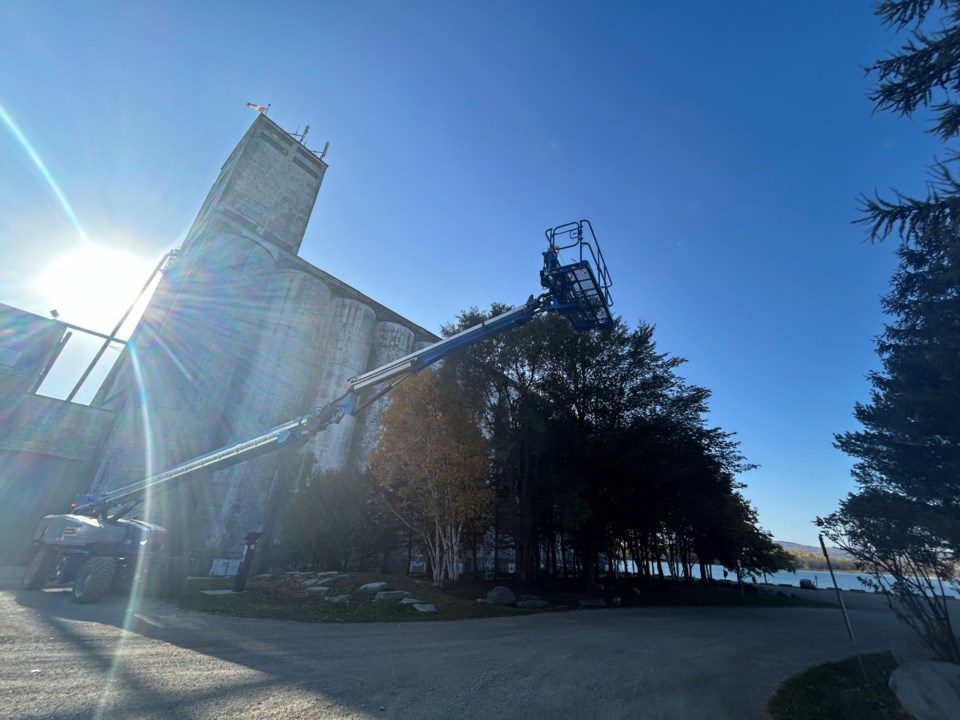Work begins today to take down empty mud nests stuck to the outside of the Terminals building at the top of the silos.
The nests were built by barn swallows, which have now flown to South America for the winter.
However, because of the pending construction at the Terminals site for the Terminals Point project, the town is working with contractors to remove the nests and put barriers in place to prevent the birds from building there again when they return in the spring.
According to Adam Gallant, the Town of Collingwood's project manager, the barn swallow nests were discovered last fall by the company hired to control pests in the Terminals building.
According to Environment and Natural Resources Canada, the barn swallow is on the federal species at risk list with a "special concern" designation, prompting the town to reach out to experts for a way forward.
The town hired Hawkeye Bird and Animal Control to help them deal with the nests and work out a way to prevent the birds from returning.
"We've been working with them basically since last fall," said Gallant. "They had to do a site visit to confirm the species ... then we needed help to make sure we're doing all the work in accordance with the federal and provincial regulations."

Some of the work included obtaining proper permits and timing the nest removal for the months when the birds are away and the nests are abandoned.
Crews will use a large lift to reach the nests and take them off the concrete structure.
"The plan is to put up ... we're calling it an 'exclusion device,' but basically it blocks off that area because they're going to come back next season and want to nest in the same area," said Gallant. "But we can't have them nesting on the building if we're planning for construction."
Exactly what will be installed is still to be determined, but likely it will be a plastic or metal shield that is too smooth for the nests to stick to, and seals the area enough that the small birds can't get behind it.
The nests are, for the most part, attached to the tops of the silos where the roof overhangs, creating a nook with walls on three sides for the nest. Barn swallows make mud nests with small circle openings on the front.
As the nest removal and installation of the plastic or metal panels is considered maintenance work, the town will foot the bill. Gallant estimated a cost around $30,000, which includes all the work done to this point, permits, and assumes the panels will work.
The areas will be inspected again in the spring, and if barn swallows have nested on the outside of the Terminals, the process will have to be repeated.
Though barn swallows are among the world's most widespread birds, there was a substantial population decline in North America beginning in the late 1980s and into 2000. However, the federal government reported a "stable" population over the last ten years.
The key threats identified for the barn swallow are: declining population of insect prey, severe temperature fluctuations during spring migration and the breeding season, and loss of suitable nesting sites.
Barn swallows eat flying insects.
In 2011, the official status designation for barn swallows in Canada from the Committee on the Status of Endangered Wildlife in Canada (COSEWIC) was listed as "threatened," but the designation was downgraded in 2021 to "special concern."
The special concern designation means the species may become a threatened or endangered species because of a combination of biological characteristics and identified threats. The threatened designation indicates the species will likely become endangered if limiting factors are not reversed.
Barn swallows breed in nearly every part of Canada and the US, as well as some areas of Mexico, and they fly to South America for the winter.
Construction isn't anticipated on the Terminals building until about 2026, according to Gallant.
"It may take a couple of attempts to make sure that we get them all cleared out of there before major construction starts," said Gallant.
Plans for the Collingwood Grain Terminals revitalization were first presented to the public in March 2023 by developer Les Mallins of Streetcar Developments Inc., with an expected price tag of $200 million overall for the project.
The project, done in collaboration with Dream Unlimited Corporation, includes renovating the Collingwood landmark into a 24-storey condominium tower, commercial spaces, a hotel, and redevelopment of the public park at Millennium Point.
As part of the project, the town has committed to improving the public realm lands, such as expanding the roads, shoreline work, improving the marina and running infrastructure along the spit on Heritage Drive. The current estimate for costs for that work which will be borne by the town’s coffers comes in at $15 million.



